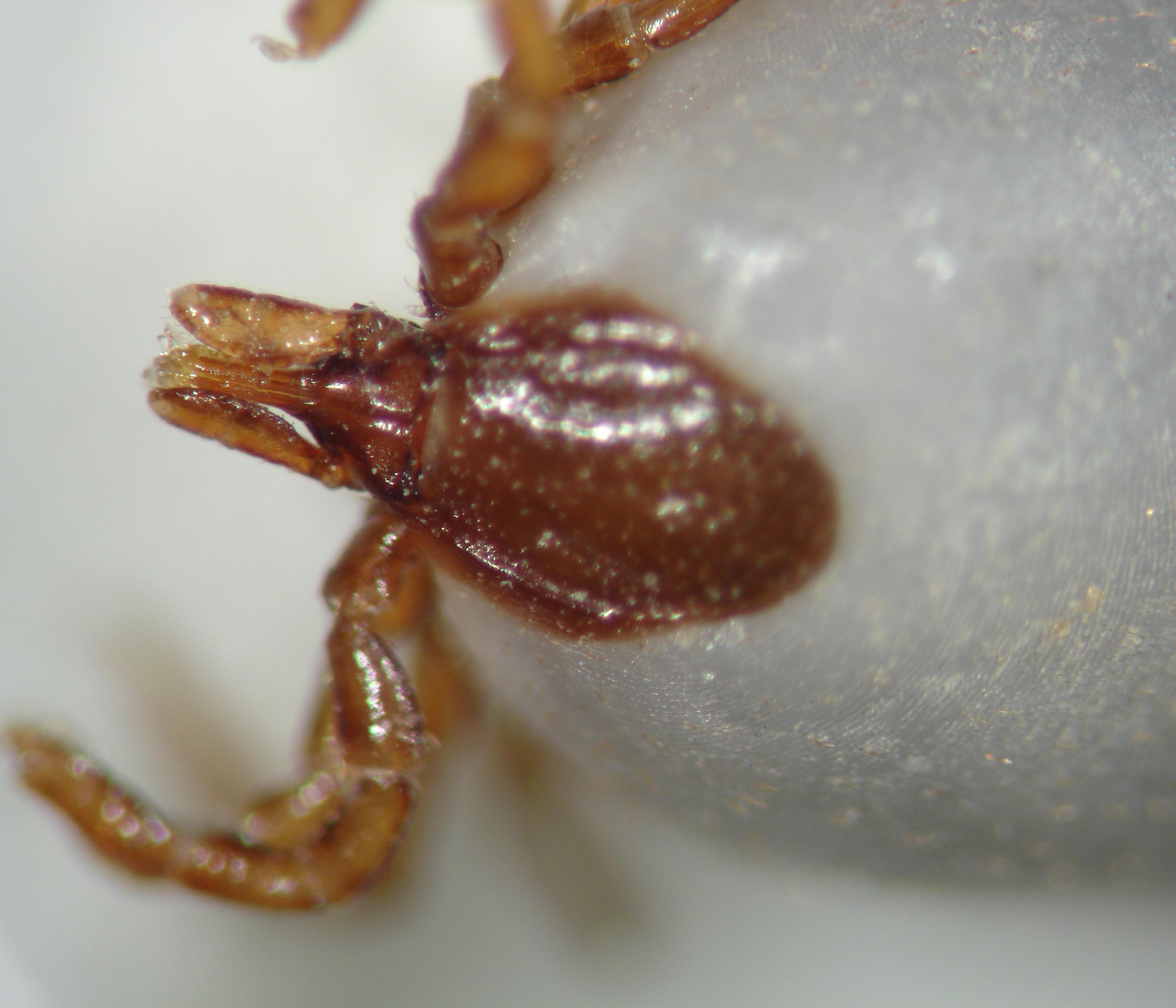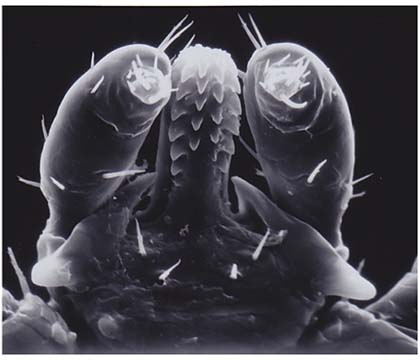
Ticks 101
April showers bring May flowers … and ticks? That's right. The increased humidity and warm weather of spring and summer provide ideal conditions for these parasites to thrive, and your pet is the perfect host.
By Sarah Figley
"Tall grass and bush are places where ticks like to hang out, so if your dog visits this type of environment, they can pick up ticks," warns Dr. Jamie Rothenburger, a veterinarian and senior resident in the Western College of Veterinary Medicine's Department of Veterinary Pathology.
She adds that ticks require moisture and humidity to stay hydrated so they're not often found in dry, sandy areas.
Rothenburger provides more information about ticks and gives some recommendations on how to keep your pet safe this summer.
What is a tick?
Ticks are arachnids: they have eight legs with separate head and body sections — just like spiders and scorpions. There are over 900 species of ticks worldwide, so it's not surprising that they come in varying shapes, sizes and colours.
Ticks can be red, brown, black or tan, and some species of ticks can be very small and hard to see or feel on your pet. Most ticks are protected by a very hard shell, which makes them resilient and difficult to kill.
Ticks latch onto their host and survive by eating blood. As they eat, their bodies grow and become engorged. In North America, deer, moose, elk, dogs, rodents and birds are major carriers of ticks, so areas with large populations of these species are suggested to be key environments for ticks.
Ticks and diseases
It's true that ticks can carry one or more diseases, but it's fairly rare that your pet will contract a tick-borne disease.
Although Lyme disease is in the spotlight right now, wood ticks (also called dog ticks) - which are a common species in Saskatchewan - do not carry the disease-causing bacteria. Blacklegged ticks (formerly called deer ticks) are the ones responsible for carrying and transmitting Lyme disease, but they do not normally cycle in Saskatchewan.
"Owners should be aware of ticks if they are traveling to a Lyme-endemic part of Canada including parts of southern Manitoba, Ontario, Quebec and the Atlantic provinces or the U.S.," explains Rothenburger.
"But keep in mind that less than 10 per cent of ticks carry the bacteria in these areas, so the chances of your dog becoming infected is probably low. Also, only a small fraction of dogs that become infected with the Lyme disease bacteria become ill."
Rothenburger notes that there are other tick-borne diseases including babesiosis, anaplasmosis, Rocky Mountain spotted fever, ehrlichiosis, hepatozoonosis and possibly bartonellosis.
The good news is that all of these diseases are quite rare in Canada; they're more prevalent in southern regions of North America. Unless you are travelling with your dog in these areas, the risk is likely low. But that risk is expected to increase with climate change: researchers have noted a rise in tick-borne diseases worldwide including Canada.
If a tick has recently bitten your animal, watch them closely. For a few weeks following the bite and/or removal of the tick, look for infections and skin irritations near the bite area. Keep an eye out for any changes in behaviour, appetite or mobility as these can be symptoms of tick-borne diseases. If you notice any changes, Rothenburger recommends contacting your veterinarian.
Preventing ticks
See your local veterinarian. Several "spot-on" medications that repel or kill ticks after they bite are available to control ticks in companion animals. Here are some more suggestions:
Visit the Council for Disease Control and Prevention website for more tips.
Checking for ticks
After spending time outdoors, take a few minutes to check for ticks on your pet. You can often find ticks crawling along your pet's skin or fur. Look and feel all over your pet, but ticks will generally migrate towards warm, dark areas such as armpits, the groin area, ears, feet (in between the toe pads on the paw) or near the anus (under the tail).

Removing ticks
Do not panic! If you are comfortable removing the tick at home, you can do so. If not, consult your veterinarian for assistance. Here are the steps for removing a tick:
Rothenburger adds that the University of Saskatchewan (U of S) conducts a tick surveillance program that's operated by Dr. Neil Chilton in the university's Department of Biology. If you find one or more ticks on your pet and wish to have them screened, submit your samples to:
Dr. Neil Chilton
Department of Biology
University of Saskatchewan
112 Science Place
Saskatoon, SK S7N 5E2
In addition to your contact information, provide the date and location of where the tick came from, the source (human, dog, cat or other species). Please note if there has been any travel outside of the province during the previous month.
Sarah Figley is a second-year veterinary student from Saskatoon, Sask., and is the WCVM's research communications intern for the summer of 2014.
She adds that ticks require moisture and humidity to stay hydrated so they're not often found in dry, sandy areas.
Rothenburger provides more information about ticks and gives some recommendations on how to keep your pet safe this summer.
What is a tick?
Ticks are arachnids: they have eight legs with separate head and body sections — just like spiders and scorpions. There are over 900 species of ticks worldwide, so it's not surprising that they come in varying shapes, sizes and colours.
Ticks can be red, brown, black or tan, and some species of ticks can be very small and hard to see or feel on your pet. Most ticks are protected by a very hard shell, which makes them resilient and difficult to kill.
Ticks latch onto their host and survive by eating blood. As they eat, their bodies grow and become engorged. In North America, deer, moose, elk, dogs, rodents and birds are major carriers of ticks, so areas with large populations of these species are suggested to be key environments for ticks.
Ticks and diseases
It's true that ticks can carry one or more diseases, but it's fairly rare that your pet will contract a tick-borne disease.
Although Lyme disease is in the spotlight right now, wood ticks (also called dog ticks) - which are a common species in Saskatchewan - do not carry the disease-causing bacteria. Blacklegged ticks (formerly called deer ticks) are the ones responsible for carrying and transmitting Lyme disease, but they do not normally cycle in Saskatchewan.
"Owners should be aware of ticks if they are traveling to a Lyme-endemic part of Canada including parts of southern Manitoba, Ontario, Quebec and the Atlantic provinces or the U.S.," explains Rothenburger.
"But keep in mind that less than 10 per cent of ticks carry the bacteria in these areas, so the chances of your dog becoming infected is probably low. Also, only a small fraction of dogs that become infected with the Lyme disease bacteria become ill."
Rothenburger notes that there are other tick-borne diseases including babesiosis, anaplasmosis, Rocky Mountain spotted fever, ehrlichiosis, hepatozoonosis and possibly bartonellosis.
The good news is that all of these diseases are quite rare in Canada; they're more prevalent in southern regions of North America. Unless you are travelling with your dog in these areas, the risk is likely low. But that risk is expected to increase with climate change: researchers have noted a rise in tick-borne diseases worldwide including Canada.
If a tick has recently bitten your animal, watch them closely. For a few weeks following the bite and/or removal of the tick, look for infections and skin irritations near the bite area. Keep an eye out for any changes in behaviour, appetite or mobility as these can be symptoms of tick-borne diseases. If you notice any changes, Rothenburger recommends contacting your veterinarian.
Preventing ticks
See your local veterinarian. Several "spot-on" medications that repel or kill ticks after they bite are available to control ticks in companion animals. Here are some more suggestions:
- Areas with ticks, fleas and heartworm mostly overlap so a good option is to treat your pet with multi-purpose, preventive medications. It's important to dose these products according to weight.
- No product is 100 per cent effective so owners who use them on their dogs should still expect to find some ticks.
- Certain tick control products for dogs can be deadly to cats. Check with your veterinarian about the safety of their use if your household includes dogs and cats. Tick products for dogs must never be used on cats.
- Be aware of dense tick environments and avoid spending time near them.
- Strategic landscaping in your yard can prevent ticks from living on your property. Here are some tips:
- keep grass short
- remove leaves and branches around the yard
- keep wood piles and bird feeders away from the house
- use wood, tile, concrete or wood chips in high traffic areas of the yard
- reduce rodent activity on your property
- if you live on an acreage or farm, discourage deer from coming near your home by building fences around food sources or planting your garden away from your house
Visit the Council for Disease Control and Prevention website for more tips.
Checking for ticks
After spending time outdoors, take a few minutes to check for ticks on your pet. You can often find ticks crawling along your pet's skin or fur. Look and feel all over your pet, but ticks will generally migrate towards warm, dark areas such as armpits, the groin area, ears, feet (in between the toe pads on the paw) or near the anus (under the tail).

Removing ticks
Do not panic! If you are comfortable removing the tick at home, you can do so. If not, consult your veterinarian for assistance. Here are the steps for removing a tick:
- Get a pair of clean tweezers.
- Wear gloves (if possible) since ticks do carry diseases.
- Separate the fur around the tick as best as possible.
- Grab the head of the tick (the part that is attached to the skin) as close to the skin as possible but be careful not to pinch your pet!
- With even pressure, pull upwards with the tweezers. Avoid twisting or bending since some parts of the tick could be left in the skin. You do not want to pull off the body and leave the head embedded in the skin, as it may cause an infection.
- Place the tick in a small container of isopropyl alcohol. This will kill the tick and also allow you to keep the evidence. If your pet develops symptoms in the days after a tick bite, your veterinarian may find it extremely helpful to know the species of tick and have access to the actual parasite for testing.
- Clean the tick bite area with isopropyl alcohol or soap and water.
- Give your pet a treat – a reward for being calm and patient.
Rothenburger adds that the University of Saskatchewan (U of S) conducts a tick surveillance program that's operated by Dr. Neil Chilton in the university's Department of Biology. If you find one or more ticks on your pet and wish to have them screened, submit your samples to:
Dr. Neil Chilton
Department of Biology
University of Saskatchewan
112 Science Place
Saskatoon, SK S7N 5E2
In addition to your contact information, provide the date and location of where the tick came from, the source (human, dog, cat or other species). Please note if there has been any travel outside of the province during the previous month.
Sarah Figley is a second-year veterinary student from Saskatoon, Sask., and is the WCVM's research communications intern for the summer of 2014.
